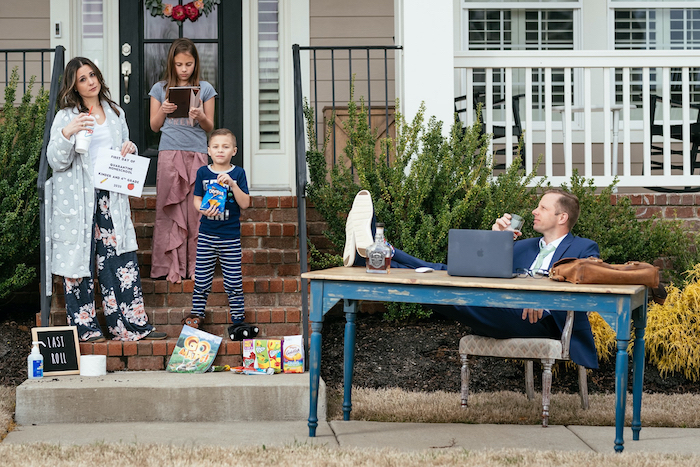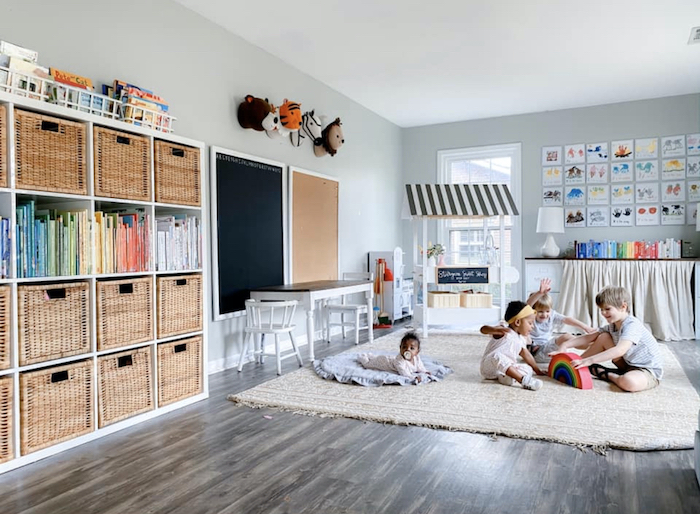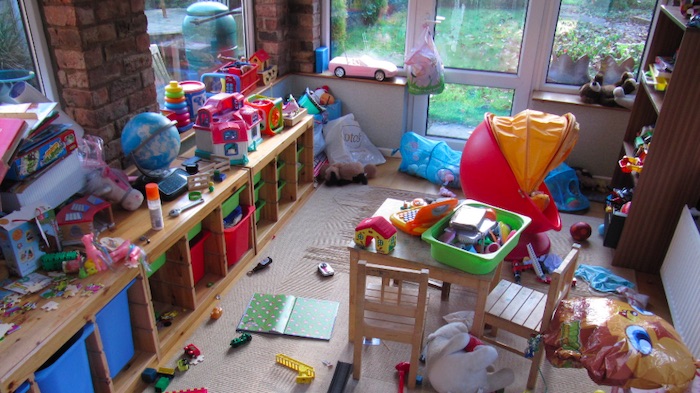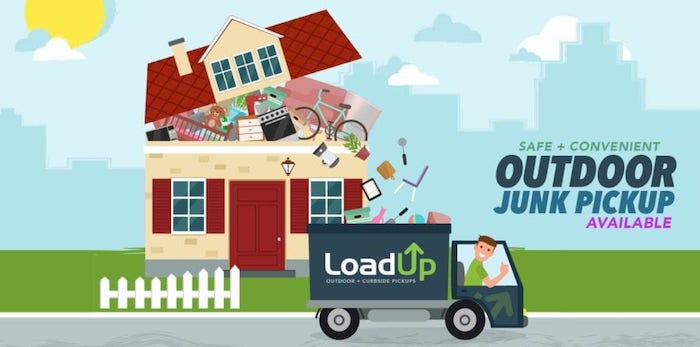
Homeschooling is usually a choice, but for many Americans right now, it’s a requirement. Whether you’re faced with a temporary homeschool situation or are dedicated to a more permanent setup, creating a successful at-home education environment can be better.
As parents ourselves, we too are experiencing the difficulty of keeping our kids focused and on-task with their schoolwork. That’s why we created this blog to walk you through the essentials for setting up a temporary homeschool classroom or work area, from designating and decluttering a space to helpful tips for keeping kids focused today.
How to Set Up a Homeschool Classroom
**Click to auto-scroll by section
Setting up Your Homeschool Classroom or Workspace

When you’re new to homeschooling, setting up your own homeschool classroom can feel overwhelming, especially if you’re also trying to work from home, as well. Setting up a space for your child’s homeschool work will help keep them focused on their own tasks during school hours, which will, in turn, give you more time to focus on your own personal needs.
Now don’t worry; You don’t have to dedicate an entire room – or even an entire area – to your new homeschool classroom space. Work with what you have, get creative and keep an open mind! Thinking outside of the box will greatly help you on your homeschooling journey.
Remember, there is really no “right” or “wrong” way to do this. If your kids work well in the kitchen one day, but then lose focus there the next, change it up. The most important thing is to keep your children on-task and entertained for the duration of the virtual school day.
Got old junk laying around? LET US TAKE THEM ❯
1. Choose an Appropriate Work Area
Here are the most important things to consider when designating a homeschool classroom space, whether it’s a new spot every day or a dedicated room:
Lighting. Your homeschool room setup should be well lit. Natural lighting, overhead lighting or even just a few good lamps will be fine.
Flat Workspace. Most of us don’t have the classic school-desk-and-chair-combo laying around at home. For a good home school desk alternative, a flat workspace with enough room to spread out papers and do classwork on a computer will work great.
Your homeschool table setup could be anything from a dining room table to a traditional desk. If at all possible, try not to use a wobbly desk or a table with a broken leg. As you know, children will find just about any reason to shift their focus away from their work when they get bored or overloaded.
Comfortable Seating. Homeschool classroom seating should be comfortable enough for kids’ to sit at for extended periods of time, but not so comfortable that they could possibly fall asleep. A desk chair is ideal, but even a kitchen chair or barstool with a back will suffice.
Storage Space. Keeping everything organized is incredibly important. Rolling carts, desk drawers, and even storage bins will help maintain a high level of organization.
The last thing you need is to be constantly interrupted by a kid looking for a pair of scissors, some paper or a pencil with a good eraser, especially if you’re also working from home. When you keep things stored in one spot, your child(ren) will be able to locate school supplies themselves, leaving you more time to focus on your own work.
Keep it Clean. Keeping workspaces clean and organized is equally important whether you have a dedicated table or desk, or a spot that is used for other things. However, when you are using a shared surface for your homeschool table setup, like a kitchen table, be extra diligent about keeping it clean and wiped down between school time and meals.
If you have a playroom, spare room or even a corner in your den or living room to dedicate to a temporary homeschool classroom, that’s great! Whether or not your homeschool learning space looks like an actual classroom is entirely up to you. The beauty of setting up a classroom at home is that you can custom tailor it to best fit your child’s educational needs and style.
📌 Looking for more inspiration? Pinterest is a great place to look for inspiration on aesthetics and design, with fun in home classroom ideas for both small and large spaces.
2. Create Rolling Homework Stations for Smaller Spaces
Although it is best to keep things in the same spot, that’s not always possible. If you live in a small space, like a crowded apartment, multi-family house, or even a tiny home, you probably don’t have a spare room available to dedicate to homeschooling.
Never fear! Since kids are only doing classwork during school hours, their classroom at home can be cleaned up at the end of the day and go back to its original purpose.
Educational Workstations
If you have a room that can be dedicated to your new homeschool classroom, try setting up educational workstations! Each workstation should represent one single subject, and be set up to maximize focus and performance on that subject while at that specific workstation.
Here are examples of educational workstations, by topic, that are great for kids of all ages:
Arts & Crafts Station: Gather up all your markers, crayons, coloring books and other arts and crafts materials. The arts and crafts station is now their new home. Arts and crafts can be done just about anywhere, including on the floor, which is a sigh of relief if you’re a little short on furniture. If you don’t have a small table and chairs that you can turn into an art station, try putting down a couple of bean bags chairs, an area rug or even a few throw pillows.
There are plenty of things around your house that can be used as a hard surface for coloring and drawing if you don’t have a table to use. Certain things can even be customized and decorated by your child to make it feel more personal. Here are a few ideas for flat surfaces for a temporary art station:
- a large, old hardcover book
- a cardboard box from your most recent Amazon.com purchase
- a piece of scrap wood (no sharp edges or nails, please!)
- the top of a storage tote
Reading Station: Create this simple and comfortable area with inflatable furniture, bean bag chairs or pillows. The reading station should be a quiet place that fosters focus and imagination at the same time, so keep it simple and filled with books.
If your room has a window, consider using that spot for your reading station.
Workbook Station: Having a large clutter-free table for kids to spread out when working on projects and studying for tests will help keep them organized and focused. Finish the area off with an ergonomic desk chair and a desk lamp.
Keep any surrounding decorations clean and minimal to reduce distractions. Try not to set this workstation up near a window, as it can easily lead to daydreaming.
Workout Station: A miniature trampoline or even some small hand weights, Pilates bands and a yoga mat can be used for a workout station.
Breaking up the day with movement and physical activity will allow kids to refocus faster by providing their brain with a healthy burst of blood oxygen.
Ready to dispose of your junk? BOOK US ❯
3. Get Rid of Clutter and Stay Organized

There’s a saying that goes, “a place for everything, and everything in its place”. This is especially applicable to homeschool classrooms and workstations. Having a place for everything and staying well-organized and clutter-free is crucial for homeschool success.
Both adults and children alike struggle to stay focused when they are surrounded by clutter. The human brain is organized, and clutter has a very negative effect on our focus and mood.
Plain and simple, there is no room for disorganization and clutter in your homeschool classroom. So now is a great time to get rid of wobbly furniture, broken electronics and other household junk taking up space. Your kids need to be able to find things easily and put those items back in their designated spots once they are finished using them.
Organizing and decluttering doesn’t have to be a solo gig. Get your kids in on the action and get creative with it! Including your children in the decluttering and organization process will give them a sense of accomplishment and pride, which will motivate them to take good care of their new homeschool classroom and everything in it.
Organize Your Supplies: Have your kids make design labels for each area. This could double as both an art and a spelling activity for them. Quiz your kids on spelling out the word or words for each label, and then have them decorate it and place it in the proper spot. This will give them a sense of ownership and responsibility for their own homeschool space.
4. Try to Stick to a Schedule
If school taught us anything, it’s that kids thrive on structure and schedules to stay focused and engaged, regardless of how old they are.
Spending too much time on one subject can lead to boredom, lack of focus and temper-tantrums, so it’s important to make a schedule and stick to it.
Remember when the teachers sent home that sheet of paper at the beginning of the school year to let parents know the breakdown of the students’ day?
Use it as inspiration when creating a homeschool schedule. Each block of time throughout the day should be dedicated to a different subject.
🍏 Pro Tip: If you know your child focuses during a certain part of the day (before or after lunch) dedicate those times for subjects that are more difficult for them or require more focus.
Computer/Table Time: You will need to have the correct technology for each child in your home. If multiple children are sharing a laptop, tablet or desktop computer, they should be on a rotation schedule. That will ensure that each child gets adequate time to do their schoolwork, while also keeping them focused on other subjects in the meantime.
5. Homeschooling Kids of Different Ages
When you have kids in different grades and with different needs and requirements, it could be a good idea to dip into what we’ve learned from the history of education.
As you probably learned in school yourself, children used to be educated inside of a one-room schoolhouse. Although adopting the one-room schoolhouse philosophy might seem like a step back in time, it actually applies very well to educating more than one child at home with different educational needs.
Whenever possible, combine activities that can be done by all ages. Try to scatter each child’s solo activities and schoolwork between group activities. This will change things up and give your kids a mental break while also keeping them (unknowingly) focused on educational tasks.
6. Hire a Junk Removal Company to Remove the Clutter

During times of social isolation, we can’t just fill up our cars with bags items to drop off at the nearest donation center after decluttering to make space for a clean and tidy homeschool classroom. That’s where LoadUp’s professional junk removal services come in.
Most junk removal companies require on-site estimates, making it impossible to use their services in a quarantine situation. Luckily, LoadUp has always had a different philosophy when it comes to junk removal:
- No On-Site Estimates: We don’t need to come into your home to give you a quote.
- Upfront Pricing: Our junk removal prices are based on the items that you need removed. We don’t have pickup minimums or charge by volume, and will remove anything from one item to an entire estate cleanout.
- Outdoor Pickups: We offer outdoor pickups that don’t require you to be there. Simply place your items outside your home or office, let us know where they’re located, and we’ll pick them up from there.
- Book Online or By Phone: When it comes to scheduling service, you have options. You can request a quote or book service online or can give us a call at (844) 239-7711 to speak to a live person.
No matter how you decide to set up a homeschool classroom, have fun with it! Keeping your kids engaged and focused on school during the day will help you all appreciate each other more during non-school hours. You can do this!
Related Articles from the Trash Talk blog:

